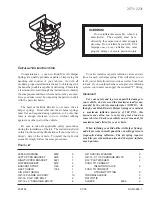
101
n
Index
Data
Te
chnolog
y
Repairs
Car care
Controls
Overview
Antilock Brake System (ABS)
The concept
ABS increases active safety by prevent-
ing the wheels from locking when brak-
ing. The reason: Locked wheels are
dangerous. When the front wheels
slide, the driver loses steering control
over the vehicle. Traction loss at the
rear wheels can cause the rear end to
break into an uncontrolled skid.
ABS is designed to meet two essential
requirements during every brake appli-
cation:
>
To help provide vehicle stability.
>
Assured ability to steer and maneuver
on the various road surfaces –
(asphalt, concrete, dirt, wet
conditions, snow, ice).
The system can achieve the shortest
braking distances possible under most
conditions (on straight-aways and in
curves, on asphalt, ice, wet road sur-
faces, etc.).
Braking with ABS
The system is operative once the vehi-
cle exceeds a speed of approx. 6 mph
(10 km/h). It is inactivated once again
below approx. 4 mph (6 km/h). There-
fore, the wheels could theoretically tend
to lock in the final phase of a braking
action, but this is insignificant in actual
practice.
If you are in a situation which requires
full braking, you will exploit the full
benefits of the ABS system if you apply
maximum brake pressure ("panic stop").
Since the vehicle maintains steering
responsiveness, you can avoid possible
obstacles with a minimum of steering
effort, despite the full brake application.
Depress the brake pedal with steady
pressure and do not release it. Do not
pump the brakes.
The ABS closed-loop control circuit
cycles in fractions of a second. The
pulsation at the brake pedal, together
with sounds generated by the hydraulic
control system, indicate to you that the
vehicle is approaching its maximum
braking range. It is a reminder to you
that you must adapt the vehicle's road
speed to existing road conditions.
On road surfaces that have a loose
surface layer on a firm base with good
traction (on gravel, deep sand or snow,
for example), braking distances may be
longer than with locked wheels. This
also applies for driving with snow
chains. However, ABS continues to
provide enhanced vehicle stability and
steering response under these condi-
tions.
Summary of Contents for Z3 COUPE
Page 1: ...e vehicle e guide ...
Page 2: ...Z3 roadster 2 3 Z3 roadster 2 8 Z3 coupe 2 8 M roadster M coupe modell ...
Page 5: ...5n ...
Page 8: ......
Page 13: ...13n ...
Page 14: ......
Page 16: ......
Page 17: ...17n Index Data Technology Repairs Car care Controls Overview ...
Page 18: ... Z3 coupe ...
Page 20: ...M coupe M roadster ...
Page 80: ......
Page 81: ...81n Index Data Technology Repairs Car care Controls Overview ...
Page 84: ...ditioning ...
Page 85: ...85n Index Data Technology Repairs Car care Controls Overview nditioning ...
Page 96: ......
Page 120: ...ter 2 3 2 8 Z3 coupe 2 8 ...
Page 121: ...121n Index Data Technology Repairs Car care Controls Overview ster 2 3 2 8 Z3 coupe 2 8 ...
Page 122: ...er M coupe ...
Page 123: ...123n Index Data Technology Repairs Car care Controls Overview ster M coupe ...
Page 143: ...143n Index Data Technology Repairs Car care Controls Overview ...
Page 144: ......
Page 154: ...turn used batteries to a cycling point or to your BMW ...
Page 174: ......
Page 180: ......
Page 187: ...187n Index Data Technology Repairs Car care Controls Overview ...
Page 188: ......
Page 194: ...ice Guide ls 132 132 114 116 rate ence 6 r 66 5 tem 66 gine 19 ...
Page 196: ...y 3 88 161 10 150 129 2 blade 6 ce gine 19 ...
Page 198: ...The Ultimate Driving Machine 01 41 0 155 149 US En ble ...
















































